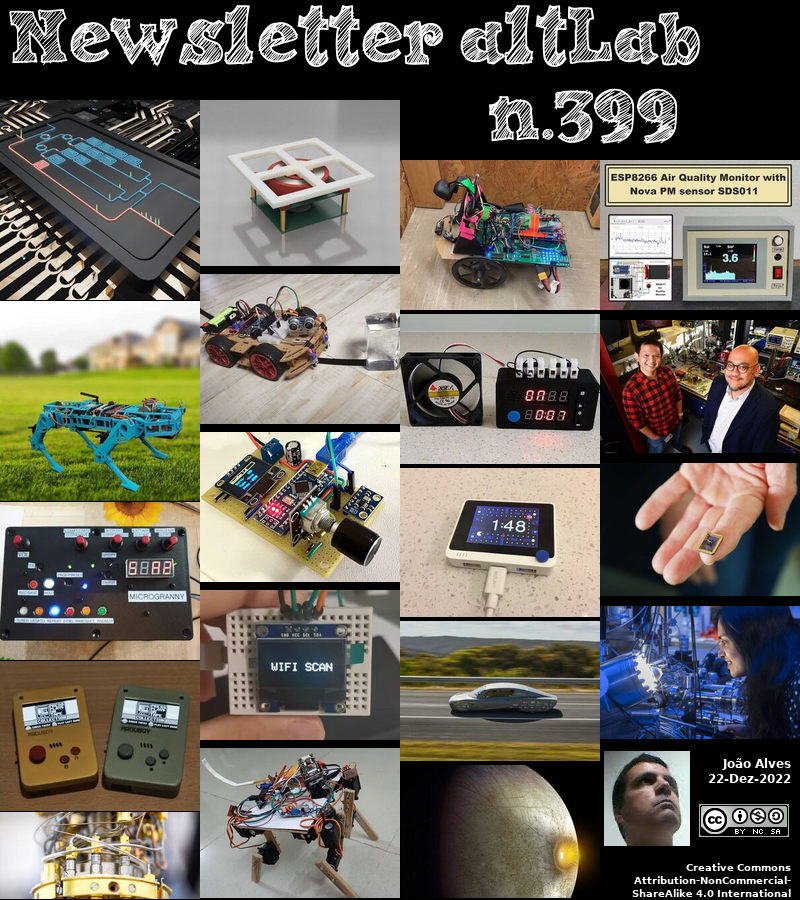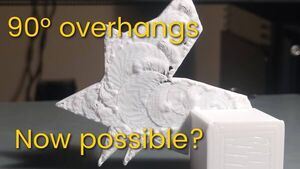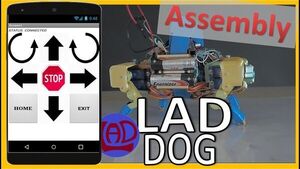2022-12-22 - Nº 399
Editorial
Esta é a Newsletter Nº 399 que se apresenta com o mesmo formato que as anteriores. Se gostar da Newsletter partilhe-a!
Todas as Newsletters encontram-se indexadas no link.
Esta Newsletter tem os seguintes tópicos:
Faz hoje anos que nascia, em 1732, o industrialista e inventor inglês Richard Arkwright. Ele ficou conhecido por ter introduzido métodos de produção de fábricas têxteis mecanizados e motorizados que foi enormemente bem sucedida. A máquina Spinning-Frame que ele inventou (1769, patente britânica nº 931) para fiar fio de algodão utilizava múltiplos conjuntos de rolos emparelhados que giravam a diferentes velocidades capazes de extrair fio com a espessura correcta, e um conjunto de fusos para torcer as fibras firmemente juntas. Produziu um fio muito mais forte do que o fio feito pela Spinning-Jenny de James Hargreaves. A máquina de Arkwright era demasiado grande para ser accionada manualmente, por isso ele alimentou-a com uma roda de água (1771) quando ficou conhecida como a Moldura de Água. O negócio têxtil de Arkwright expandiu-se, ele construiu mais fábricas, e mais tarde adoptou a força do vapor.
Faz também hoje anos que nascia, em 1765, o matemático alemão Johann Friedrich Pfaff. Ele propôs o primeiro método geral de integração de equações diferenciais parciais da primeira ordem. Pfaff fez um trabalho importante sobre funções especiais e a teoria das séries. Ele desenvolveu o Teorema de Taylor utilizando a forma com o restante como dado por Lagrange. Em 1810 contribuiu para a solução de um problema devido a Gauss relativo à elipse da maior área que podia ser desenhada dentro de um determinado quadrilátero. O seu trabalho mais importante sobre as formas de Pfaff foi publicado em 1815, quando tinha quase 50 anos, mas a sua importância só foi reconhecida em 1827, quando Jacobi publicou um artigo sobre o método de Pfaff.
Faz igualmente hoje anos que nascia, em 1799, o físico irlandês Nicholas Callan. Ele foi pioneiro na ciência eléctrica. Ele inventou a bobina de indução (1836) antes da do mais conhecido Heinrich Ruhmkorff. A bobina de Callan foi construída utilizando uma bobina de ferro em forma de ferradura com uma bobina secundária de fio isolado fino sob um enrolamento separado de fio isolado grosso como bobina "primária". Cada vez que a corrente de uma bateria através da bobina "primária" era interrompida, uma corrente de alta tensão era produzida na bobina "secundária" separada electricamente. Em 1837, Callan utilizou um mecanismo de relógio para abanar um fio dentro e fora de um pequeno copo de mercúrio para interromper o circuito 20 vezes/segundo numa máquina de indução gigante, produzindo faíscas de 15 polegadas (estimadas em 600.000 volts).
Faz também hoje anos que nascia, em 1876, o engenheiro e metalúrgico sueco-americano Gustav Waldemar Elmen. Ele criou a Permalloy (1916) e ligas conexas com alta permeabilidade magnética utilizadas em equipamento de comunicações. Uma liga com esta propriedade pode ser facilmente magnetizada e desmagnetizada, especialmente útil para aplicações em equipamento eléctrico, telefones e outros sistemas de comunicações. Desenvolveu a Permalloy de níquel-ferro em 1916, para a Western Electric Company (mais tarde Bell Telephone Laboratories). Mais tarde, em 1923, Elmen descobriu que a permeabilidade magnética poderia ser dramaticamente aumentada se Permalloy fosse tratada com calor. A sua permeabilidade magnética excedeu a do aço de silício. A sua descoberta tornou possível cabos telegráficos de grande capacidade de transporte de mensagens em alto mar.
Por fim, faz hoje anos que nascia, em 1887, o matemático indiano Srinivasa Ramanujan. Ele fez um notável trabalho sobre séries hipergeométricas e fracções contínuas. Na teoria dos números, ele descobriu propriedades da função de partição. Embora autodidacta, ele foi um dos maiores génios matemáticos da Índia. Trabalhou em funções elípticas, fracções contínuas, e séries infinitas. A sua notável familiaridade com os números, foi demonstrada pelo incidente seguinte. Enquanto Ramanujan estava no hospital em Inglaterra, o seu professor de Cambridge, G. H. Hardy, visitou e observou que tinha apanhado o táxi número 1729, um número singularmente inexcepcional. Ramanujan respondeu imediatamente que este número era de facto bastante notável: é o menor número inteiro que pode ser representado de duas maneiras pela soma de dois cubos: 1729=1^3+12^3=9^3+10^3.
Em 1882, o primeiro fio de luzes eléctricas a decorar uma árvore de Natal foi criado para a sua casa por Edward H. Johnson, um associado de Thomas Edison. Anteriormente, as árvores tinham sido decoradas com velas de cera. A edição de Dezembro de 1901 do Ladies' Home Journal anunciava as lâmpadas da árvore de Natal, feitas pela primeira vez comercialmente pela Edison General Electric Co. of Harrison, N.J. em cordas de nove tomadas, cada uma com uma miniatura de 2 velas, 32 volts, lâmpada de filamento de carbono*. As luzes das árvores de Natal rapidamente se tornaram a fúria entre os americanos ricos, mas o cidadão médio só as utilizou nos anos 20 ou mais tarde. As lâmpadas de caracteres tornaram-se populares nos anos 20, as lâmpadas de bolhas nos anos 40, as lâmpadas cintilantes nos anos 50 e as lâmpadas de plástico em 1955.
Na Newsletter desta semana apresentamos diversas noticias, artigos científicos, projetos de maker assim como alguns videos interessantes. São apresentadas as revistas MagPi nº 125 e Hackspace Magazine Nº 62 de Janeiro de 2023, assim como o livro C & GUI Programming 2nd Edition. Aproveito para desejar a todos votos de Boas Festas.
 João Alves ([email protected])
João Alves ([email protected])
O conteúdo da Newsletter encontra-se sob a licença  Creative Commons Attribution-NonCommercial-ShareAlike 4.0 International License.
Creative Commons Attribution-NonCommercial-ShareAlike 4.0 International License.
Novidades da Semana
Outras Notícias

IBM and Rapidus Form Strategic Partnership to Build Advanced Semiconductor Technology and Ecosystem in Japan
"IBM and Rapidus today announced a joint development partnership to advance logic scaling technology as part of Japan's initiatives to become a global leader in semiconductor research, development, and manufacturing. Rapidus Corporation researches, develops, designs, manufactures, and sells advanced logic semiconductors, and was established with the endorsement of major Japanese companies. As part of this agreement, Rapidus and IBM will further develop IBM's breakthrough 2 nanometer (nm) node technology for implementation by Rapidus at its fab in Japan. This work will leverage IBM's decades of expertise in semiconductor research and design. In 2021, IBM announced that it had developed the world's first 2 nm node chip, which is projected to achieve 45% better performance or 75% more energy efficiency than leading 7 nm chips. IBM has a long history of successful joint development partnerships with Japanese semiconductor manufacturers in advanced logic and memory technology, as well as Japanese equipment and material suppliers." [...]

13th Gen Intel Core Platform Crosses 9 GHz in Overclocking Frequency World Record
"The 13th Gen Intel® Core™ desktop processor family has overtaken the longstanding processor overclocking frequency world record. In less than three months, the Intel® Core™ i9-13900K has twice set the frequency overclocking world record. The ASUS overclocking team officially set a new world record for overclocking, pushing the 13th Gen Intel Core i9-13900K past the 9 gigahertz barrier to 9.008 GHz. Additionally, the team set new records in PIFAST (6.85 seconds) and SUPERPI 1M (3.822 seconds). Combining the Core i9-13900K with the ROG MAXIMUS Z790 APEX – and a healthy dose of liquid helium – the ASUS overclocking team became the latest to showcase the unprecedented overclocking performance in Intel’s unlocked processors. Working with partners like ASUS, Intel continues to provide desktop enthusiasts and gamers with the best processors and features for overclocking in the PC industry." [...]
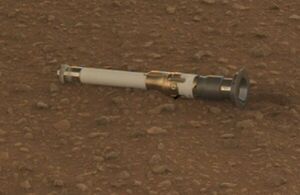
NASA’s Perseverance Rover Deposits First Sample on Mars Surface
"Filled with rock, the sample tube will be one of 10 forming a depot of tubes that could be considered for a journey to Earth by the Mars Sample Return campaign. A titanium tube containing a rock sample is resting on the Red Planet’s surface after being placed there on Dec. 21 by NASA’s Perseverance Mars rover. Over the next two months, the rover will deposit a total of 10 tubes at the location, called “Three Forks,” building humanity’s first sample depot on another planet. The depot marks a historic early step in the Mars Sample Return campaign. Perseverance has been taking duplicate samples from rock targets the mission selects. The rover currently has the other 17 samples (including one atmospheric sample) taken so far in its belly." [...]

STMicroelectronics enhances digital power combination controller for overload stability and regulation
"STMicroelectronics’ STNRG011A digital power combination controller for 90W to 300W power supplies features enhanced overload management that ensures accurate output-voltage regulation when overcurrent protection is active. Integrating a power-factor correction (PFC) controller, LLC resonant half-bridge controller, 800V startup circuitry, and supervisory engine, the STNRG011A is used in power adapters, chargers, and television and lighting power supplies. The multi-mode PFC controller implements performance-enhancing features including input-voltage feedforward, a distortion optimizer, and frequency limitation. The digital supervisory engine features an 8-bit core and dedicated peripherals, with digital algorithms stored in internal ROM to ensure reliability and a minimal bill of materials (BoM). Compared to the existing STNRG011, the STNRG011A with its new overload-management algorithm increases the switching frequency when overcurrent protection is triggered. In addition to maintaining output-voltage regulation, this also prevents unwanted shutdown of the power supply." [...]
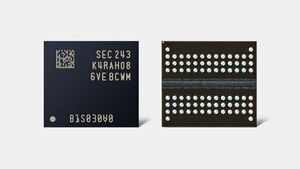
Samsung Electronics Develops Industry’s First 12nm-Class DDR5 DRAM
"Set to begin mass production in 2023, Samsung’s new DRAM will advance next-generation computing, data centers and AI applications with industry-leading performance and greater power efficiency Samsung Electronics today announced the development of its 16-gigabit (Gb) DDR5 DRAM built using the industry’s first 12-nanometer (nm)-class process technology, as well as the completion of product evaluation for compatibility with AMD. “Our 12nm-range DRAM will be a key enabler in driving market-wide adoption of DDR5 DRAM,” said Jooyoung Lee, Executive Vice President of DRAM Product & Technology at Samsung Electronics. “With exceptional performance and power efficiency, we expect our new DRAM to serve as the foundation for more sustainable operations in areas such as next-generation computing, data centers and AI-driven systems.” “Innovation often requires close collaboration with industry partners to push the bounds of technology,” said Joe Macri, Senior VP, Corporate Fellow and Client, Compute and Graphics CTO at AMD. “We are thrilled to once again collaborate with Samsung, particularly on introducing DDR5 memory products that are optimized and validated on ‘Zen’ platforms.” This technological leap was made possible through the use of a new high-κ material that increases cell capacitance and proprietary design technology that improves critical circuit characteristics. Combined with advanced, multi-layer extreme ultraviolet (EUV) lithography, the new DRAM features the industry’s highest die density, which enables a 20 percent gain in wafer productivity. Leveraging the latest DDR5 standard, Samsung’s 12nm-class DRAM will help unlock speeds of up to 7.2 gigabits per second (Gbps)." [...]
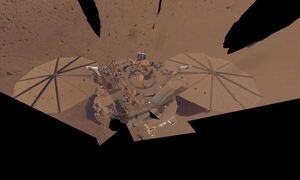
NASA Retires InSight Mars Lander Mission After Years of Science
"The mission has concluded that the solar-powered lander has run out of energy after more than four years on the Red Planet. NASA’s InSight mission has ended after more than four years of collecting unique science on Mars. Mission controllers at the agency’s Jet Propulsion Laboratory in Southern California were unable to contact the lander after two consecutive attempts, leading them to conclude the spacecraft’s solar-powered batteries have run out of energy – a state engineers refer to as “dead bus.” NASA had previously decided to declare the mission over if the lander missed two communication attempts. The agency will continue to listen for a signal from the lander, just in case, but hearing from it at this point is considered unlikely. The last time InSight communicated with Earth was Dec. 15. “I watched the launch and landing of this mission, and while saying goodbye to a spacecraft is always sad, the fascinating science InSight conducted is cause for celebration,” said Thomas Zurbuchen, associate administrator of NASA’s Science Mission Directorate in Washington." [...]

Europe's Vega C rocket fails on 2nd-ever mission, 2 satellites lost
"The Vega C was carrying two spacecraft for Airbus' Pléiades Neo Earth-imaging constellation. The second mission of Europe's new Vega C rocket did not go according to plan. The medium-lift Vega C lifted off from Europe's Spaceport in Kourou, French Guiana on Tuesday (Dec. 20) at 8:47 p.m. EST (10:47 p.m. local time; 0147 GMT on Dec. 21), carrying two satellites for Airbus' Pléiades Neo Earth-imaging constellation. The rocket's first stage, known as the P120C, did its job. But the second stage, called the Zefiro 40, did not. "Approximately 2 minutes and 27 seconds after liftoff an anomaly occurred on the Zefiro 40, thus ending the Vega C mission," representatives of Arianespace, the French company that operates the Vega C, said in an emailed statement on Tuesday night." [...]
Ciência e Tecnologia

Comet Impacts Could Bring Ingredients for Life to Europa’s Ocean
"Comet strikes on Jupiter’s moon Europa could help transport critical ingredients for life found on the moon’s surface to its hidden ocean of liquid water — even if the impacts don’t punch completely through the moon’s icy shell. The discovery comes from a study led by researchers at The University of Texas at Austin, where researchers developed a computer model to observe what happens after a comet or asteroid strikes the ice shell, which is estimated to be tens of kilometers thick. The model shows that if an impact can make it at least halfway through the moon’s ice shell, the heated meltwater it generates will sink through the rest of the ice, bringing oxidants — a class of chemicals required for life — from the surface to the ocean, where they could help sustain any potential life in the sheltered waters. The researchers compared the steady sinking of the massive melt chamber to a foundering ship. “Once you get enough water, you’re just going to sink,” said lead author and doctoral student Evan Carnahan. “It’s like the Titanic times 10.” Scientists have proposed impacts as a means to transport oxidants on Europa, but they assumed the strikes would have to break through the ice." [...]
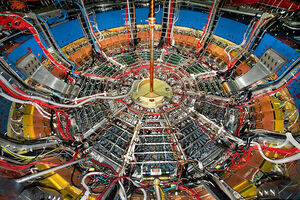
What Triggers Flow Fluctuations in Heavy-Ion Collision Debris?
"Comprehensive study pointing to initial state influences on particle flow patterns will help nuclear physicists zero in on key properties of matter that mimics the early universe Scientists in the STAR collaboration at the Relativistic Heavy Ion Collider (RHIC)—an atom smasher at the U.S. Department of Energy’s Brookhaven National Laboratory—have published a comprehensive analysis aimed at determining which factors most influence fluctuations in the flow of particles from heavy ion collisions. The results, published in Physical Review Letters, will help the scientists zero in on key properties of a unique form of matter that mimics the early universe. The matter these physicists are interested in is called a quark-gluon plasma (QGP)—a trillion-degree soup of quarks and gluons. These are the most fundamental building blocks of all visible matter, the components that make up the protons and neutrons of atomic nuclei. RHIC creates this hot quark soup by colliding beams of large nuclei (a.k.a. heavy ions)." [...]
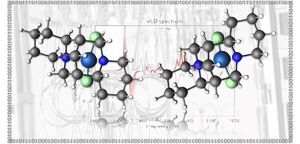
Quantum technology grant for modelling molecular mirror images
"Prof. Wybren Jan Buma of Molecular Photonics at the Van ‘t Hoff Institute for Molecular Sciences will take part in research using the new Dutch quantum supercomputer. Together with Prof. Luuk Visscher of Theoretical Chemistry at VU University he has just been granted funding through the National Growth Fund programme Quantum Technology, for the quantum simulation of molecular mirror images. The new Dutch quantum supercomputer will be put to the task of determining the correct molecular mirror image. Just like with people, we have that the mirror image of a molecule looks almost identical but still is crucially different: Imagine putting your right hand in a left-hand glove! For molecules this may imply the difference between an effective drug and a potentially dangerous substance. The researchers in this project aim to develop a combination of measurement and quantum simulations which can unambiguously determine whether we have the desired molecule and not its mirror image." [...]

The Donnan Potential, Revealed at Last
"First-ever direct measurement of the electric potential at the liquid-membrane interface could push new research in energy, biology, and materials science The Donnan electric potential arises from an imbalance of charges at the interface of a charged membrane and a liquid, and for more than a century it has stubbornly eluded direct measurement. Many researchers have even written off such a measurement as impossible. But that era, at last, has ended. With a tool that’s conventionally used to probe the chemical composition of materials, scientists at the Department of Energy’s Lawrence Berkeley National Laboratory (Berkeley Lab) recently led the first direct measurement of the Donnan potential. Crumlin and his collaborators recently reported the measurement in Nature Communications. Such a measurement could yield new insights in many areas that focus on membranes." [...]

Self-assembled power
"Rechargeable batteries to benefit from the development of lithium-loving foams. Lithium batteries could soon enjoy puffed-up performance thanks to a highly ordered inorganic foam discovered at KAUST. The self-assembling foam features a complex hierarchical structure that allows it to repeatedly soak up and then release large quantities of lithium ions with ease. The material could become a key component of fast-charging, long-lived lithium batteries. The inorganic substance molybdenum disulfide (MoS2) has been earmarked as a promising potential lithium-ion battery (LIB) anode material. “Its high theoretical capacity for lithium coupled with its earth abundance and its easy solution processability make MoS2 an attractive LIB anode candidate,” says Xuan Wei, a Ph.D. student in Vincent Tung’s labs, who led the work." [...]

New sensor uses MRI to detect light deep in the brain
"Using this approach, researchers can map how light spreads in opaque environments. Using a specialized MRI sensor, MIT researchers have shown that they can detect light deep within tissues such as the brain. Imaging light in deep tissues is extremely difficult because as light travels into tissue, much of it is either absorbed or scattered. The MIT team overcame that obstacle by designing a sensor that converts light into a magnetic signal that can be detected by MRI (magnetic resonance imaging). This type of sensor could be used to map light emitted by optical fibers implanted in the brain, such as the fibers used to stimulate neurons during optogenetic experiments. With further development, it could also prove useful for monitoring patients who receive light-based therapies for cancer, the researchers say." [...]

EV record breakers! Sunswift 7 goes 1000km on a single charge in world’s best time
"UNSW Sydney’s student-built solar-powered car averaged nearly 85km/h over 12 hours to set Guinness World Record with just eight minutes to spare. UNSW Sydney’s Sunswift 7 solar-powered electric car has claimed a Guinness World Record by going 1000km on a single charge in under 12 hours. The car, designed and built by students, posted a verified time of 11 hours 52.08 minutes for the distance at the Australian Automotive Research Centre (AARC) in Wensleydale, Victoria. That equates to an average speed of nearly 85km/h and secured the Sunswift Racing team the record for the ‘Fastest EV over 1000km on a single charge’. The official honour – and Guinness World Record certificate – was conferred a few days later once timing information and car telemetry data had been analysed and confirmed by a team of experts. Sunswift Team Manager Andrea Holden, a Mechanical Engineering student at UNSW Sydney, was delighted with the car’s performance and ecstatic to be part of a prestigious world record." [...]
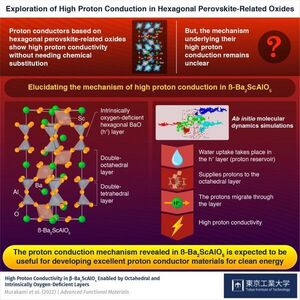
Research on proton conductors holds promise for development of clean energy materials
"Researchers from Tokyo Institute of Technology (Tokyo Tech) and ANSTO have recently found high proton conductivity in a hexagonal perovskite oxide without the need for chemical substitution in the material. The research has been published in Advanced Functional Materials. Proton conductors hold great promise in the field of clean energy but creating oxygen vacancies for high proton conduction is challenging. Electrochemical devices such as fuel cells are becoming indispensable for new power generation technologies because they can efficiently produce renewable energy. Ceramic proton conductors can be used in many applications, including protonic ceramic fuel cells (PCFCs), hydrogen pumps, sensors, and separation membranes. In particular, the PCFCs based on ceramic proton conductors are promising can work at lower temperatures compared with the conventional solid oxide fuel cells (SOFCs), because of the higher conductivity of protons at low temperatures." [...]

Putting a new spin on computer hardware
"Luqiao Liu utilizes a quantum property known as electron spin to build low-power, high-performance computer memories and programmable computer chips. Luqiao Liu was the kind of kid who would rather take his toys apart to see how they worked than play with them the way they were intended. Curiosity has been a driving force throughout his life, and it led him to MIT, where Liu is a newly tenured associate professor in the Department of Electrical Engineering and Computer Science and a member of the Research Laboratory of Electronics. Rather than taking things apart, he’s now using novel materials and nanoscale fabrication techniques to build next-generation electronics that use dramatically less power than conventional devices. Curiosity still comes in handy, he says, especially since he and his collaborators work in the largely uncharted territory of spin electronics — a field that only emerged in the 1980s. “There are many challenges that we must overcome in our work." [...]

A Shield For 2D Materials That Adds Vibrations To Reduce Vibration Problems
"Monash University researchers have demonstrated a new, counterintuitive way to protect atomically-thin electronics -- adding vibrations, to reduce vibrations. By 'squeezing' a thin droplet of liquid gallium, graphene devices are painted with a protective coating of glass, gallium-oxide. This oxide is remarkably thin, less than 100 atoms, yet covers centimetre-wide scales, making it potentially applicable for industrial large-scale fabrication. Current, frontier "2nm" transistors from IBM use gates of similar thickness, close to 10nm (140 atoms). "Mechanically transferring such large-area nanosheets is quite novel," says lead author Matthew Gebert. The oxide provides a new method of device protection, whilst also improving device performance: "The oxide not only enhances and protects our devices when we first transfer it, but also later, during subsequent processing and fabrication," says co-author Semonti Bhattacharyya." [...]
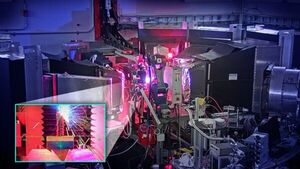
VULCAN forges new science for the future of 3D-printed metal
"From carbon fiber to concrete and bamboo, additive manufacturing—the industrial term for 3D-printing—utilizes many different materials and techniques. And now, with a significant need for decarbonization and alternative supply chains for converting raw materials into finished products, 3D-printed metal could make a big impact on the future of manufacturing. A key technique in metal additive manufacturing involves “printing,” or creating layers upon layers of metal welds to build an object. It offers a more customizable, on-demand alternative to traditional methods that involve pouring molten metal into a mold or machining or cutting metal to create a shape. But developing new technology also means solving new problems. That’s why researchers at the Department of Energy’s (DOE’s) Oak Ridge National Laboratory (ORNL) have created a one-of-a-kind automated robotic platform that allows them to study the microscopic behavior of additive metal welds in real time as they’re being created." [...]
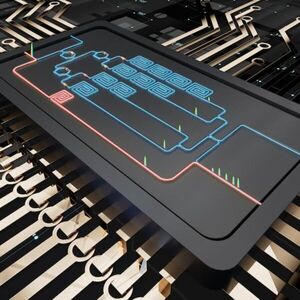
Light years ahead: the advanced chip shaping an ultrafast tech future
"Research led by Monash University, RMIT and the University of Adelaide has developed an accurate method of controlling optical circuits on fingernail-sized photonic integrated circuits. The development, published in the prestigious international journal Optica builds on the work by the same team who recently created the world’s first self-calibrated photonic chip. Photonics, or the use of light particles to store and transmit information, is a burgeoning field, supporting our need to create faster, better, more efficient and more sustainable technology. Programmable photonic integrated circuits (PICs), offer diverse signal processing functions within a single chip, and present promising solutions for applications ranging from optical communications to artificial intelligence. Whether it's downloading movies or keeping a satellite on course, photonics is radically changing the way we live, revolutionising the processing capability of large scale equipment onto a chip the size of a human fingernail. Earlier this year, researchers at Monash University, RMIT and the University of Adelaide developed an advanced photonic circuit which could transform the speed and scale of photonics technology." [...]

Designing better battery electrolytes
"Looking at the future of battery materials. Designing a battery is a three-part process. You need a positive electrode, you need a negative electrode, and -- importantly -- you need an electrolyte that works with both electrodes. An electrolyte is the battery component that transfers ions -- charge-carrying particles -- back and forth between the battery's two electrodes, causing the battery to charge and discharge. For today's lithium-ion batteries, electrolyte chemistry is relatively well-defined. For future generations of batteries being developed around the world and at the U.S. Department of Energy's (DOE) Argonne National Laboratory, however, the question of electrolyte design is wide open." [...]
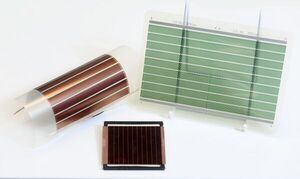
CityU scientists discover a novel photophysical mechanism that has achieved record-breaking efficiency for organic photovoltaics
"Organic photovoltaics (OPVs) are a promising, economical, next-generation solar cell technology for scalable clean energy and wearable electronics. But the energy conversion loss due to the recombination of photogenerated charge carriers in OPVs has hindered further enhancement of their power conversion efficiency (PCE). Recently, researchers from City University of Hong Kong (CityU) overcame this obstacle by inventing a novel device-engineering strategy to successfully suppress the energy conversion loss, resulting in record-breaking efficiency. The best-performing OPVs developed by the CityU team have achieved PCE of over 19%, and the team expects to exceed 20% very soon. The discovery is promising for the commercialisation of OPVs. OPVs, a solar cell technology based on organic semiconductors, are regarded as a promising candidate for clean energy because of their low material toxicity and vast molecular tunability in photoactive materials." [...]
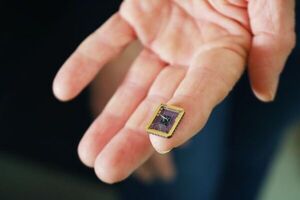
At the Edge of Graphene-Based Electronics
"A pressing quest in the field of nanoelectronics is the search for a material that could replace silicon. Graphene has seemed promising for decades. But its potential faltered along the way, due to damaging processing methods and the lack of a new electronics paradigm to embrace it. With silicon nearly maxed out in its ability to accommodate faster computing, the next big nanoelectronics platform is needed now more than ever. Walter de Heer, Regents’ Professor in the School of Physics at the Georgia Institute of Technology, has taken a critical step forward in making the case for a successor to silicon. De Heer and his collaborators developed a new nanoelectronics platform based on graphene — a single sheet of carbon atoms." [...]
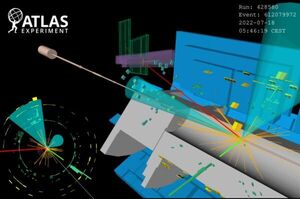
ATLAS moves into top gear for Run 3
"In their first Run 3 results, the ATLAS collaboration measured two Standard Model processes: the production of Z bosons and top-quark pairs After over three years of upgrade and maintenance work, the Large Hadron Collider began its third period of operation (Run 3) in July 2022. Since then, the world’s most powerful particle accelerator has been colliding protons at a record-breaking energy of 13.6 TeV. The ATLAS collaboration has just released its first measurements of these record collisions, studying data collected in the first half of August 2022. The researchers measured the rates of two well-known processes: the production of top-quark pairs and the production of a Z boson, which proceed through strong and electroweak interactions, respectively. The ratio of their cross sections is sensitive to the inner structure of the proton, and their measurement sets constraints on the relative probabilities that reactions are initiated by quarks and gluons. These early measurements also validate the functionality of the ATLAS detector and its reconstruction software, which underwent many improvements in preparation for Run 3." [...]

A Rough Start Can Lead to a Strong Bond
"The manufacturing industry is constantly on the lookout for more efficient manufacturing materials, but most new methods to develop such materials created in the lab are not suited for industrial-scale use. Now, investigators from The Institute of Industrial Science at The University of Tokyo have developed a cheap and simple method of bonding polymers to galvanized steel--steel with a coating of zinc layered over it--to create a lightweight and durable material that can feasibly be produced on an industrial scale. As the manufacturing sector becomes increasingly incentivized to think about the environmental impact of their processes, new techniques are needed to ensure that parts can be made both sustainably (with a minimum of harsh chemicals and waste) and with a long lifetime before needing to be replaced. Galvanized steel is widely used in the automobile industry owing to its excellent mechanical properties and corrosion resistance. However, because of its weight, polymer-metal composites are being increasingly applied as alternative lightweight materials with high durability. Unfortunately, traditional techniques to bond polymers to galvanized steel are unsuited for mass production as they often require harsh chemicals or specialized equipment." [...]

Brightening dark excitons with photonic crystals
"Researchers are working to improve 2D semiconductors by better understanding dark excitons and how they could be applied to future technologies ranging from quantum computers to next-generation solar panels. Dr. Shoufeng Lan, assistant professor in the J. Mike Walker ’66 Department of Mechanical Engineering at Texas A&M University, is leading a project to explore how the optically inactive “dark” variant of excitons — the bound state of an electron and electron-hole pair often found in semiconductors — can be accessed and manipulated in a new way. This would allow for a variety of applications in quantum materials. The discoveries from the research support a better understanding of the fundamental aspects of dark excitons, with potential implementation in future next-generation devices, quantum computers and more efficient solar panels. “This demonstration is poised to pave the way for applications such as quantum information processing, quantum computing, photonic circuitry and valleytronics that use the fascinating features of dark excitons for encoding and transporting information,” Lan said. The research, titled “Coherent momentum control of forbidden excitons,” was published recently in the journal Nature Communications." [...]

Designing quantum materials with quantum computers
"Designing quantum materials with specific exotic quantum properties is one of the greatest challenges in quantum technologies and material science. Specifically, predicting the behavior of collective quantum systems pushes computational capabilities to their limit, and predicting correlated quantum materials is beyond even the most powerful classical computers, present or future. However, quantum computers can potentially tackle some of these issues. As our current quantum computers are early-stage and imperfect, a key question is how to develop algorithms that provide faithful predictions of quantum materials with near-term quantum computing resources. The Jane and Aatos Erkko Foundation has funded a proposal that shows how imperfect quantum algorithms allow for understanding the behavior of quantum materials. The project, led by Professor Christian Flindt and Professor Jose Lado at the Department of Applied Physics in Aalto University, demonstrates a new methodology to predict the behavior of two specific families of quantum materials using near-term quantum computing resources." [...]

Photonic Chip With Record-Breaking Radio Frequency Dynamic Range
"Researchers at the University of Twente have developed a revolutionary programmable integrated microwave photonic filter with a record-breaking dynamic range. This represents a major breakthrough in the integration of functionality and performance in radio frequency photonic signal processors. Prof Dr David Marpaung, one of the authors of the study says: "Our work breaks the conventional and fragmented approach of integration, functionality and performance that currently prevents the adoption of these photonic systems in real applications. Traditional radio frequency filters can only work in a narrow frequency range, meaning you need several separate filters for broadband operation. Our device is integrated, broadband, and has an enormous dynamic range, making it possible to use just a single photonic circuit for various frequency ranges.” MANY APPLICATIONS The research shows that the filter can play a key role in modern radio frequency and microwave applications, including cognitive radio, multi-band all-spectrum communications, and broadband programmable front-ends. Before this discovery, programmable microwave photonic circuits with such advanced functions had poor performance." [...]
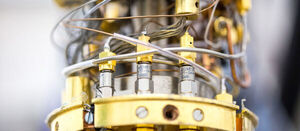
Researchers use quantum mechanics to see objects without looking at them
"The new method bridges the quantum and classical worlds and could improve measurements in quantum computers and other applications We see the world around us because light is being absorbed by specialized cells in our retina. But can vision happen without any absorption at all – without even a single particle of light? Surprisingly, the answer is yes. Imagine that you have a camera cartridge that might contain a roll of photographic film. The roll is so sensitive that coming into contact with even a single photon would destroy it. With our everyday classical means there is no way there’s no way to know whether there’s film in the cartridge, but in the quantum world it can be done." [...]
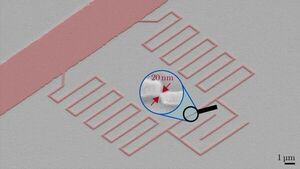
More stable states for quantum computers
"KIT researchers are working on a new qubit approach - publication in Nature Materials Quantum computers are considered the computers of the future. A and O are quantum bits (qubits), the smallest computing unit of quantum computers. Because they not only have two states, but also states in between, qubits process more information in less time. However, maintaining such a state for longer is difficult and depends in particular on the material properties. A KIT research team has now created qubits that are 100 times more sensitive to material defects - a crucial step in eradicating them. The team published the results in the journal Nature Materials (DOI: 10.1038/s41563-022-01417-9 )." [...]
Documentação
A documentação é parte essencial do processo de aprendizagem e a Internet além de artigos interessantes de explorar também tem alguma documentação em formato PDF interessante de ler. Todos os links aqui apresentados são para conteúdo disponibilizado livremente pelo editor do livro.
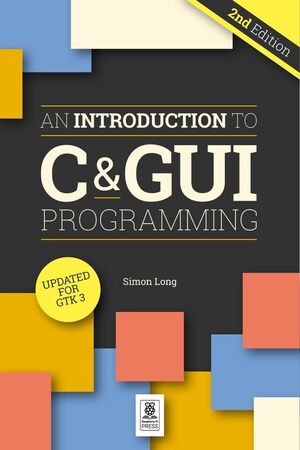
C & GUI Programming 2nd Edition
"Freshly updated for GTK3, the 2nd edition of An Introduction to C & GUI Programming will teach you all you need to know to write simple programs in C and start creating GUIs, even if you’re an absolute beginner. The first half of the book is an introduction to C, and covers the basics of writing simple command-line programs. The second half shows how to use the GTK user interface toolkit with C to create feature-rich GUI applications which can be run on the desktop. - 156 pages of essential information: - Create simple command-line C programs - Control flow with conditions and loops - Handle variables, strings, and files - Design graphical user interface applications in C - Handle user input with buttons and menus - Use advanced UI features such as data stores and dialogs" [...]
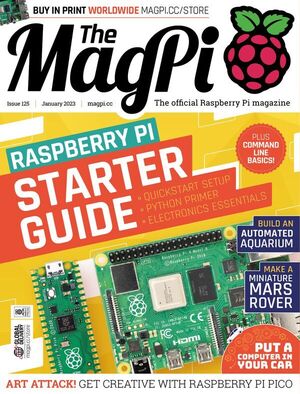
The MagPi 125
"- Complete Raspberry Pi Starter Guide. Your first QuickStart and Raspberry Pi OS system guide. - Python code and electronics. A super-fast primer to doing projects that combine code with electronics. - Get started with the command line. Discover the beating heart of Linux by getting to grips with text-based commands." [...]
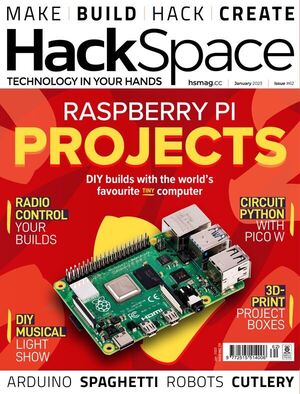
HackSpace magazine #62
"It’s not yet Christmas, but we come bearing glad tidings: the supply of Raspberry Pis available to hobbyists is starting to come back to normal. To celebrate, we’re exploring 20 of the best hardware projects you can build with a Raspberry Pi — whether that’s large or small, simple or complex, useful or not-so-useful. - Keep your posterior warm with a home-built heated seat - Build custom electronics enclosures out of 3D printed parts and M3 bolts - Communicate with Mastodon using a Raspberry Pi Pico W - Power many, many LEDs" [...]
Projetos Maker
Diversos Projetos interessantes.

Arduboy DIY with FX
"Instruction for build homemade Arduboy with FX Prepare step 1. Prepare all part that must use in project and solder tools 2. 3D print the case" [...]

Mini WiFi Scanner using OLED
"Modifying code example for ESP32 WiFi Scanner to display on OLED instead of Serial Monitor The codes generated from this project is by modifying code of others (The reference link is attached below). It comes to my mind when I learn about how to use esp32. From the blog, the WiFi scanner data is displayed via Serial monitor. I am thinking "Hmm.. can I just try to display it on OLED, to make it cuter and cooler?" With some times of learning, eventually I have made it >w< From the website I referred, it is using a 38 pins of ESP32 to realize the project. Instead, I am using a 30 pins of ESP32, so the GPIOs may be different." [...]
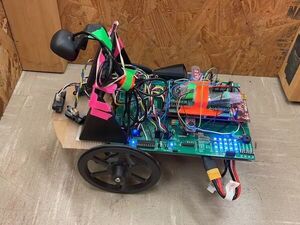
High way lane switch + obstacle avoidance autonomous robot
"The robot imitates a vehicle on the highway through changing lanes, producing a honking noise, and avoiding obstacles with infrared sensors. The team built a robot base from ME461. The project is based off the two-wheeled robot with a caster. The three-wheel robot is controlled by a TI launchpad F28379D. Besides, the three-wheel robot also contains a microphone, two wheel optical encoders and a 10 DOF IMU. To make the robot car capable of doing more intensive computation and communication, the team decided to add a Raspberry Pi 4 on it." [...]
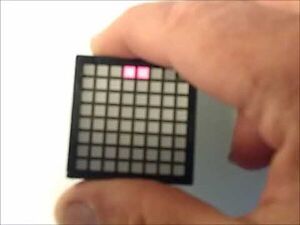
Matrix Spirit Level
"A dual axis spirit level that uses a MPU-6050 Motion Tracking Sensor and is displayed on a 8x8 LED matrix. Many years ago I bought a fancy square 8x8 Matrix LED from Futurlec. They aren't expensive (around $2 each), they just seemed to be always out of stock whenever I ordered them. Anyway one did arrive and I have been keeping it for a special project so that I could show it off. This project seemed to be the right fit for it. My primary goal when designing this project was keeping the size as small as possible." [...]

Lora rfm95 simple Gateway
"DIY LoRa rfm95 simple Gateway to send and receive messages on the LoRa network! We want to be able to create our own lora-gateway! We want to understand systems, capabilities and possibilities. People have built it, but detailed information is hard to find. That's why we created this project. It's a work in progress, we're working on it right now." [...]
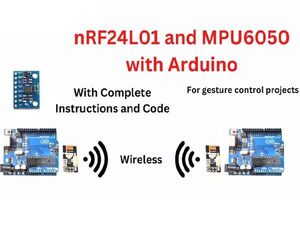
How to Connect nRF24L01 and MPU6050 for Gesture Control
"This project shows how to connect nRF24L01 Radio Module and MPU6050 with Arduino for projects that require Gesture Control This project shows how to connect nRF24L01 Radio Module and MPU6050 with Arduino for projects that require gesture control. The Arduino on the TX side reads the data from the MPU6050 connected to it and this data is transmitted to the Arduino on the RX side by the nRF24L01 Radio Modules. Once the data is received by the Arduino on the RX side, it prints the received data on the Serial Monitor. This project can be modified and used in any other projects that require gesture control. " [...]

Arduino Based 4-Legged Mobile Robot Built From Scratch
"A 4-legged mobile robot that tracks and wiggles its tail when it sees a human face. It can be controlled from remote PC through WiFi. The development of terrestrial locomotion of legged robots has been continuously growing over the past few decades irrespective of the complexities involved in the design and development of these robots. This is because of the advantages in terms of maneuverability, transverse ability, ability to navigate on different terrains, efficiency, navigation over obstacles etc they have over wheel robot vehicles. The advantages of legged locomotion depend on the postures, the number of legs, and the functionality of the leg. The quadruped robots are the best choice among all legged robots related to mobility and stability of locomotion." [...]
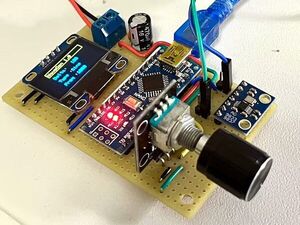
Simple Bench Signal Generator
"A simple to make AD9833-based bench signal generator, suitable for 10Hz–1Mhz - for actual practical use. The AD9833 (and boards that contain it, such as the GY-9833) is a great little signal generator. But using one means one needs a couple of libraries from among many possible choices; many user interface decisions; some pushbutton magic; and some construction if the device is to be actually useful. Having looked around and found many previous project options, I decided that too much choice is confusing, and most of those options had some imperfections or bugs that I would consider showstoppers. So I put together my own, using an Arduino Nano and a few simple libraries that are included with the IDE, and a bunch of code and some construction - and described it in a manual. That manual is of the essence here, by the way: good documentation is essential in any project." [...]
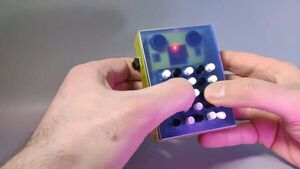
TS-DET1 – micro:bit keypad synth with detuning
"It feels rewarding to use a device by leveraging its unique traits, and the BBC micro:bit has two features that are rarely found onboard other microcontrollers: a LED matrix and gyro sensor. So, I decided to design a circuit that detects and displays tilting, and uses it to alter the pitch of the notes being played. The result is a quirky musical toy, surprisingly expressive and with a personality of its own. The input part of the instrument is a 5×5 matrix of tactile push buttons, each one paired with a diode to prevent ghosting (ghosting as in false input. Diodes won’t solve unrequited love issues.) Some of the pins used as key inputs are shared with the LED matrix, requiring to continuously switch the display off and back on, which results in a noticeable flicker." [...]
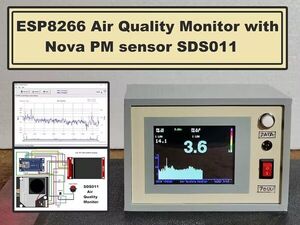
ESP8266 Air Quality monitor with Nova PM Sensor SDS011
"This device measured both PM10 and PM2.5 particles uses the Nova PM SDS011 Laser Sensor, and has a graphic presentation on a TFT display. This time I will show you how to make a device that monitors the quality of fine dust particles in the atmosphere. It measured both PM10 and PM2.5 particles uses the Nova PM SDS011 Laser Sensor. This sensor has a built-in fan which greatly simplifies construction and it has built-in logic-level serial communication providing direct readings of the PM2.5 and PM10 values without having to use maths to manipulate PWM values to obtain the results. The sensor itself is delivered together with a USB to Serial converter, so we can connect it directly to the USB port of the PC. In that case, we need to use appropriate software that we can download from the sensor manufacturer's website (http://inovafitness.com/en/a/chanpinzhongxin/95.html)." [...]
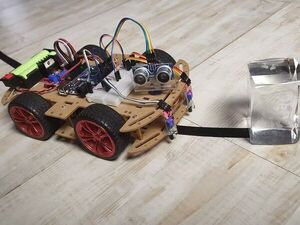
Line Follower with Obstacle Avoiding Robot
"How to Make Line Follower with Obstacle Avoiding Robot using Arduino and L298 Motor Driver" [...]
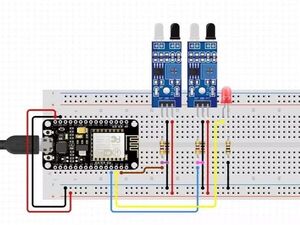
IOT based visitor counter
"This project is on IOT based visitor counter, we have used ThingSpeak as IOT cloud platform and twitter api to tweet the visitor count data. This project is all about IOT based visitor counter, initial phase is about getting required output on serial monitor that is Displaying people entered, people left and people in the room, the later phase is about sending the data to ThingSpeak cloud and tweeting when the required condition is met. This project is implemented using NODE MCU, IR Sensor and Thing tweet API. The core logic of this project is that sensors have been placed on entry and exit spots whenever a person makes movement then IR sensor goes low and count will be incremented and sequentially the data is sent to cloud. HTTP post method and react have been used to tweet the required string when 10 people have entered the room" [...]
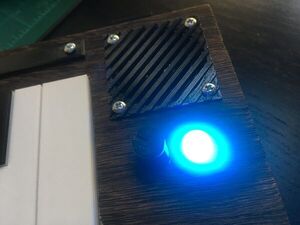
Early Experiments With 3D Printed Light Pipes
"One of the problems with my F0 synth was its power indicator LED. It was so bright, you basically couldn’t look at it straight on without being blinded! There are a couple solutions to an overly bright LED, the obvious being to limit its supplied voltage, but another idea is to use a light pipe: a component that redirects light from one place to another. Additionally and importantly, it can act as a sort of lampshade, diffusing a concentrated bright bulb over a larger surface area. " [...]
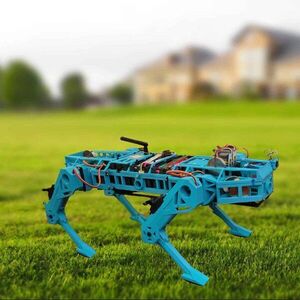
LOTP Robot Dog V2
"Modular Autonomous Quadruped Robot Project(Open Source) DESCRIPTION - Designed with Fusion 360® - Coded in Arduino language on Teensy 3.5 & Arduino - Modular structure (Lidar, Drone, Gas detection) - Autonomous features (Avoiding obstacle, maintain balance, pressure control) - PI (Proportion - Integral) control - Inverse Kinematics & Kinematics formulas applied - Sense Capacity: Lidar, Gas detection, Pressure sensors Gyroscope, GPS, Wi-Fi connection, Camera Animal-inspired drones and robots have now been observed accomplishing a wide variety of tasks, including surveillance, predictive maintenance in industrial settings, and as mobile payload transportation system for when a situation becomes too dangerous for a human. But unlike the current robots, I wanted to make a quadruped robot dog that was comprised entirely of replaceable modules rather than a monolithic system. This modular approach allows for the robot to be adapted in many more ways than a traditional one, and as new modules are introduced, the platform's capabilities can be greatly enhanced. This Project which is called “LOTP” (stands for “Line On The Paper”) and it has been awarded the 1. Prize of TUBITAK Regional Science and Technology Competition, awarded the 3. Prize of TUBITAK National Science and Technology Competition in Robotics & Coding branch and awarded the 1." [...]

Pacman Clock - Seeed Wio Terminal
"Build your own interactive Pacman Clock for your work bench or desk!! Some time ago I developed an Arduino and ESP32 Pacman Clock which proved to be popular with DIY electronics Makers. I was looking for an alternative all in one platform device that meant no electronics skills would be required so I reworked the code to work with a Seeed Wio Terminal and the results were pretty cool. The Wio Terminal is a SAMD51-based microcontroller with Wireless Connectivity powered by Realtek RTL8720DN that’s compatible with Arduino and MicroPython. Currently, wireless connectivity is only supported by Arduino. It runs at 120MHz (Boost up to 200MHz), 4MB External Flash and 192KB RAM." [...]
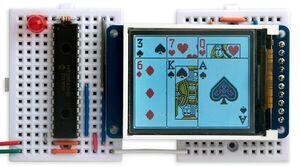
Minimal GIF Decoder
"This is a GIF image decoder designed to allow GIF images to be read and displayed by a small microcontroller It's useful if you want to decode GIF images from the flash memory on the processor, or from an SD card, and display them on a TFT or OLED display. The Minimal GIF Decoder takes about 1K bytes of program memory, and requires just over 12K bytes of RAM, so it will run on any processor with at least 16K bytes of RAM. I used an AVR128DA28. As a demonstration of the GIF encoder I've included a slide-show application that displays a sequence of different images read from the processor's flash memory. I also give details of how to display GIF images from an SD card. Introduction The GIF image format is ideal for storing images to be displayed on a small TFT or OLED display." [...]

Indoor Air quality analysis using ESP32 and Bytebeam cloud
"A CO2, temperature and humidity meter using ESP32 and Bytebeam cloud for indoor air quality analysis and monitoring. ndoor air quality (IAQ) monitoring is a very often talked about topic nowadays as it critically affects a person's health, comfort, and safety. People who might be at their homes, workplace offices, etc. typically spend more than 90% of their time in indoor environments. So, It is not only directly related to occupational health but also has a significant impact on the quality of life of people. One of the key indicators of indoor air quality is Carbon dioxide (CO2) and it has a substantial influence on public health." [...]

Mail Notifier - WiFi Edition
"After around 18 months of using my previous mail notifier the mobile network provider that I was using, ASDA, decided to move from EE’s network to Vodafone’s network. Unfortunately, the A9G GPRS module doesn’t like the Vodafone network very much and I was unable to find another pay-as-you-go provider using EE’s network that didn’t have silly terms like requiring a £10 top-up every few months to keep the SIM active, even if it still has plenty of credit. Luckily, I had moved into a new apartment where the letter box is on the front door rather than in a lobby area. That means it’s now in range of my WiFi network! This mail notifier has a much simpler design than the previous notifier; it does away with the ATtiny402, battery charging and GPS stuff and replaces the A9G module with an ESP-M2 WiFi module housing an ESP8285, similar to the ESP8266 but with embedded flash. It still uses the same lithium battery and reed switch though." [...]
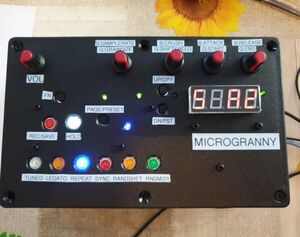
Microgranny Sampler: Completely Home-built (not a Kit!)
"The Bastl Microgranny is a fun and quirky arduino-based granular sampler, ideal for electronic music-making. It's been around in one form or another since around 2014, but you can readily buy the new Monolith design, and the older design, and kits are also still sold. However the code and schematics are in the public domain and open source, so if you are feeling brave you can build one at home without a kit! This is what I have done and am describing in this Instructable. In doing so, I saved some money and learnt quite a lot about how to hack this device. The build on this page currently describes the basic sampler unit, without the MIDI or the audio recording features." [...]

Three wires to rule them all: CD4094 & CD4021 shift register tutorial
"What do you do when your microcontroller does not have enough pins? In this tutorial we will learn how to use shift registers to control LEDs and to read out pushbuttons, all with just three wires! In six steps, we will learn all about the CD4094 output-type shift register, the CD4021 input-type shift register, and how to use them with a PIC microcontroller. And in the end we will pit it all to use with an SNES game controller, which—you guessed it—also uses shift registers on the inside. As usual, you can find a detailed list in the components box. The main for today's tutorial are: - The CD4094 output-type shift register." [...]

General Purpose Relay Timer
"A battery powered timer with a settable OFF time and ON time. Dual output relay connections accessible via screw terminals. Over the years I have build many timers and of course many Apps abound for your mobile phone. But when I really wanted one to simply automatically switch on and off a circuit that I was working on, none of them fitted the bill. So I built this relay timer. In Menu mode (timer not running), the Stop & Start buttons step through the following configurable items: - Off format - Displayed as "OF F" - Determines whether the OFF time shown is in hours and minutes or in minutes and seconds." [...]
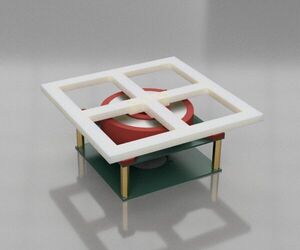
DIY Turntable Rotating Platform
"Hey guys how you doing So here's something revolutionary: a DIY Turntable Rotating Platform created entirely from scratch utilizing a unique PCB and 3D-printed parts. Because it spins, it is revolutionary. Was this a dad joke, perhaps? Without getting too funny, this system is propelled by a tiny gear DC motor and is entirely powered by a single 3.7V 18650 Li-ion cell. With the exception of the changing motor type, I repurposed a PCB from an older project that used a fume extractor. That project functioned similarly to this one." [...]
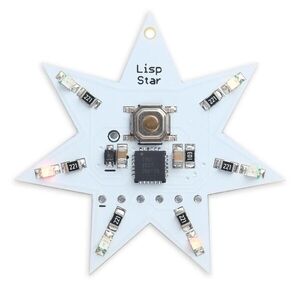
Lisp Star
"The Lisp Star is a star-shaped pendant that you can program in Lisp to make its six coloured LEDs twinkle in different patterns The pendant is based on the ATtiny3227, a microcontroller with 32Kbytes of flash memory and 3Kbytes of RAM, enough memory to run an integer version of my Lisp interpreter, uLisp. To program it you connect to it from a computer via the six pads on the front of the pendant, and you can then enter a program written in uLisp, or edit an existing program, via a serial terminal or the Serial Monitor in the Arduino IDE. I must admit that my original motivation for designing this was the incongruity of an item of jewellery running a high-level programming language. But it has a more serious application: many non-technical people who would like to learn about programming are not particularly motivated by "Hello World" programs, or programs that perform mathematical calculations, but they might be inspired by the idea of designing their own pattern of flashing LEDs on a pendant. It's powered by a 3V coin cell on the back. Press the push button to run the Lisp program and start the pendant twinkling, and press it again to turn it off." [...]
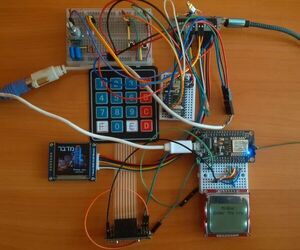
Midbar V2.0
"With the development of cryptanalysis and new hacking techniques, the cost of accessing your data without your authorization continues to decline, making it easier and more attractive for different sides to get it. I'm not going to get into details about the motivation of each side and the goals they're trying to achieve by obtaining your data. Instead, I would like to focus on the solution to that problem. In my opinion, the only way to keep your data private is to raise the costs of unauthorized access to it as high as possible, ideally higher than any reward that a third side can get by obtaining your data. Doing so puts away the incentives to access your data without your permission. To raise the cost of unauthorized access to your data - I've developed Midbar (which later on "evolved" into a multi-user Cipherbox, and now it kinda turned back into Midbar because I realized that a "multi-user Midbar" is superfluous and not as stable as a single-user one)." [...]
Secção Videos
Videos interessantes.
That's all Folks!



